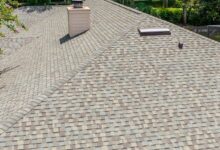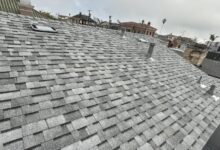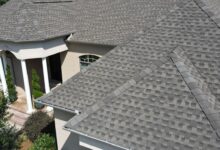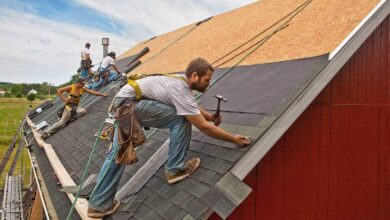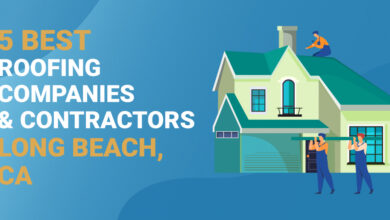Home Roofers Near Me: Finding the Right Contractor
Home roofers near me—this simple search phrase reveals a complex need. Finding a reliable roofing contractor involves careful consideration of factors like experience, licensing, pricing, and customer reviews. Users searching for “home roofers near me” often require various services, ranging from minor repairs to complete roof replacements, encompassing diverse roofing materials and budgetary constraints. Understanding these nuances is key to effectively connecting with potential clients.
This exploration delves into the competitive landscape of local roofing businesses, analyzing their online presence, marketing strategies, and pricing models. We’ll also uncover content strategies designed to attract potential customers, including informative blog posts, compelling visuals, and methods for building trust and credibility. The goal is to provide a comprehensive guide for both homeowners seeking roofing services and roofing businesses aiming to enhance their online visibility and attract more clients.
Understanding Local Search Intent for “Home Roofers Near Me”
When a user searches for “home roofers near me,” they’re typically experiencing a problem with their roof and need immediate assistance. This search indicates a high level of urgency and a strong preference for local, readily available services. The user is likely looking for a solution, not just information.
The user’s primary goal is to find a reputable and qualified roofing contractor in their immediate vicinity. This search implies a need for convenience and speed, as roof damage can often lead to further problems if not addressed promptly. Their expectations include a quick response, clear pricing, and a demonstrable track record of successful projects.
Key Factors Influencing Contractor Choice
Several key factors heavily influence a user’s decision when choosing a roofing contractor based on a “home roofers near me” search. These factors combine to create a comprehensive assessment of the contractor’s suitability and trustworthiness. The prominence of online reviews and ratings is crucial, often outweighing other factors for many users.
- Online Reviews and Ratings: Positive reviews and high ratings on platforms like Google My Business, Yelp, and Angie’s List are paramount. Users rely heavily on the experiences of others to gauge a contractor’s reliability and quality of work.
- Proximity and Accessibility: The contractor’s location is a significant factor, as users want someone nearby to minimize travel time and costs. This is especially important for urgent repairs.
- Pricing and Transparency: Clear and upfront pricing is essential. Users want to avoid hidden fees or unexpected costs, often comparing quotes from multiple contractors.
- Licensing and Insurance: Verification of proper licensing and insurance is a critical element in ensuring the contractor’s legitimacy and protection against potential liabilities.
- Website and Online Presence: A professional website with detailed information about services, experience, and contact information builds trust and credibility.
Types of Roofing Services Sought
Users searching for “home roofers near me” are seeking a wide variety of roofing services, depending on their specific needs. These needs range from minor repairs to complete roof replacements, reflecting the diverse challenges homeowners face.
- Roof Repairs: This encompasses a broad range of issues, including leak repairs, shingle replacements, and gutter cleaning. These are often urgent needs driven by immediate damage or potential water damage.
- Roof Replacements: This involves a complete overhaul of the existing roof, often due to age, severe damage, or a desire for an upgrade. This is a more significant investment and requires thorough planning and execution.
- Roof Inspections: Users may seek preventative maintenance through professional roof inspections to identify potential problems before they escalate into costly repairs.
- Emergency Roof Services: This covers urgent situations like storm damage or significant leaks that require immediate attention.
Examples of Related User Queries
Variations in search queries reveal diverse needs and priorities among users. Analyzing these variations provides valuable insights into the nuances of their search intent.
- “Emergency roof repair near me”: This indicates an urgent need for immediate assistance with a critical roofing problem.
- “Best roofers near me”: This suggests a user prioritizes quality and reputation over other factors.
- “Cheap roofers near me”: This indicates a focus on affordability, potentially at the expense of other considerations.
- “Roofers near me with financing options”: This highlights the importance of payment flexibility for the user.
- “Roof replacement cost near me”: This reveals a user focused on understanding the financial implications of a roof replacement before contacting contractors.
Competitor Analysis of Local Roofing Businesses
Understanding the competitive landscape is crucial for any roofing business aiming for success. This analysis examines three local roofing companies, comparing their online presence, pricing, and marketing strategies to identify strengths and weaknesses. This information can inform strategic decision-making and improve market positioning.
Website Feature Comparison
The following table compares the websites of three local roofing companies (names and URLs are replaced with placeholders for confidentiality). This comparison focuses on key features that influence customer perception and engagement.
| Company Name | Website URL | Key Features | Customer Review Summary |
|---|---|---|---|
| Company A | [Website URL Placeholder A] | Detailed service descriptions, online scheduling, high-quality images of completed projects, multiple contact methods (phone, email, contact form), blog with roofing tips, service area map. | Mostly positive reviews praising professionalism and quality of work; some minor complaints about communication delays. Average rating: 4.5 stars. |
| Company B | [Website URL Placeholder B] | Basic service descriptions, limited imagery, phone number and email address only, few customer testimonials, no blog or additional resources. | Fewer reviews than Company A; mixed reviews with some praising affordability, others citing concerns about workmanship. Average rating: 3.0 stars. |
| Company C | [Website URL Placeholder C] | Comprehensive service list with pricing, online quote request form, customer testimonials prominently displayed, before-and-after photos, strong emphasis on warranties and guarantees. | High number of positive reviews emphasizing excellent customer service and efficient work; few negative reviews. Average rating: 4.8 stars. |
Pricing Strategies
Local roofing companies employ diverse pricing strategies. Company A uses a project-based pricing model, providing detailed quotes after a thorough assessment. Company B offers tiered pricing packages for common roofing services, promoting transparency but potentially limiting customization. Company C utilizes a combination of project-based and hourly rates, offering flexibility but requiring clear communication to avoid unexpected costs.
Marketing Approaches
The three companies utilize different marketing strategies. Company A employs a multi-channel approach, including search engine optimization (SEO), social media marketing, and local advertising. Company B primarily relies on word-of-mouth referrals and local networking. Company C heavily invests in online advertising, particularly pay-per-click (PPC) campaigns targeting specific keywords.
Competitor Strengths and Weaknesses
Company A demonstrates strength in its comprehensive website and multi-channel marketing, but could improve communication responsiveness based on customer reviews. Company B’s affordability is a potential strength, but its limited online presence and mixed reviews hinder its reach and reputation. Company C’s strong online presence and positive customer reviews are significant strengths, although its pricing may be perceived as less competitive than Company B.
Content Ideas for Attracting Potential Customers
Attracting potential customers requires a multi-pronged approach that leverages various content formats to address their needs and concerns. By providing valuable information and establishing expertise, we can build trust and encourage potential clients to choose our services. The following content ideas focus on frequently asked questions, comparisons with competitors, and practical guidance for homeowners.
Roof Repair and Replacement FAQs
This blog post will address common questions homeowners have about roof repairs and replacements. Clear, concise answers will alleviate anxieties and demonstrate our understanding of customer concerns. Topics could include the signs of a failing roof, the cost of repairs versus replacement, the typical lifespan of different roofing materials, and the process involved in obtaining necessary permits. For example, a frequently asked question might be “How do I know if I need a repair or a full replacement?” The answer would explain the visual indicators of damage, such as missing shingles, curling edges, or water stains, and how the extent of the damage dictates the necessary course of action. Another frequently asked question could be about insurance claims, detailing the process of filing a claim and the documentation required.
Local Roofing Company Advantages
This content will highlight the benefits of choosing a local roofing company over a national chain. Focusing on personalized service, community involvement, and quicker response times will resonate with local homeowners. A comparison table could illustrate the differences, showcasing factors such as responsiveness, warranty options, and local knowledge. For example, a local company might offer same-day emergency repairs, unlike a national chain that might have longer wait times due to logistical constraints. Furthermore, local companies often support local charities and businesses, fostering a stronger sense of community engagement.
Choosing the Right Roofing Material
This detailed guide will assist homeowners in selecting the appropriate roofing material for their homes. The guide will cover various materials, such as asphalt shingles, tile, metal, and slate, comparing their durability, cost, lifespan, and aesthetic appeal. It will also discuss factors like climate, home style, and budget to help homeowners make informed decisions. For example, a homeowner in a high-wind area might find metal roofing more suitable due to its superior resistance to strong winds, while a homeowner in a humid climate might opt for tile roofing due to its excellent water resistance. A table comparing the pros and cons of each material, including estimated lifespan and cost per square foot, would be a valuable addition.
Roof Maintenance and Lifespan Extension
This content will provide practical tips for maintaining a roof and extending its lifespan. Regular maintenance can significantly prolong the life of a roof, saving homeowners money in the long run. The tips will include regular inspections, cleaning gutters, removing debris, and addressing minor repairs promptly. Examples of preventative measures include trimming overhanging branches to prevent damage from falling debris and ensuring proper ventilation to prevent moisture buildup. Regular inspections, ideally twice a year, will allow for early detection of problems, preventing minor issues from escalating into costly repairs.
Visual Content Strategy
A compelling visual content strategy is crucial for attracting potential customers and showcasing your roofing company’s expertise. High-quality images and videos can effectively communicate the value of your services and build trust with prospective clients. Infographics and detailed material descriptions further enhance understanding and engagement.
High-quality visuals are essential for demonstrating the quality of your workmanship and building customer confidence. This section outlines a strategy for creating impactful visual content that will attract and convert leads.
Before-and-After Roof Repair/Replacement Image
This image should feature a striking before-and-after comparison of a roof repair or replacement project. The “before” side should clearly show the damage, such as missing shingles, significant wear, or water damage. The “after” side should highlight the completed work, showcasing the new, meticulously installed roofing materials. Details like the precise alignment of shingles, the clean lines of the flashing, and the overall improved aesthetic appeal should be clearly visible. The lighting should be consistent in both images to allow for a clear comparison. A homeowner’s smiling face in the “after” picture would also add a personal touch and increase emotional engagement.
Roofing Company Work Process Video
This video should provide a concise overview of the company’s work process, from initial consultation to final cleanup. Each stage should be showcased, emphasizing the meticulous attention to detail and adherence to safety protocols. The video could open with a brief introduction by a company representative, followed by footage of workers safely installing roofing materials, using appropriate safety equipment like harnesses and hard hats. Close-up shots of skilled craftsmanship, such as precise shingle placement and careful sealing, would demonstrate expertise. Time-lapse footage could compress the longer processes, maintaining viewer interest. The video should conclude with a satisfied customer testimonial and contact information.
Infographics Explaining Common Roofing Problems and Solutions
A series of infographics can effectively communicate complex information in a visually appealing and easily digestible format. Each infographic should focus on a single, common roofing problem, such as shingle damage, leaks, or ice damming. The infographic should clearly illustrate the problem using simple visuals and concise text, then provide clear, step-by-step solutions. For example, an infographic on shingle damage could show images of damaged shingles alongside explanations of the causes (e.g., age, weather damage) and solutions (e.g., repair, replacement). Using bold colors and clear fonts will make the information easily accessible.
Images Illustrating Different Roofing Materials and Their Benefits
Several high-resolution images should showcase the various roofing materials offered by the company. Each image should feature a close-up of the material, highlighting its texture, color, and unique characteristics. Accompanying text should detail the material’s benefits, such as durability, energy efficiency, and aesthetic appeal. For example, an image of asphalt shingles could highlight their affordability and wide range of color options. An image of metal roofing could showcase its longevity and resistance to extreme weather conditions. An image of tile roofing could highlight its classic aesthetic and superior lifespan. Each description should include a concise summary of the material’s pros and cons to provide a balanced perspective.
Building Trust and Credibility
Building trust is paramount for any roofing company, especially when dealing with a significant home improvement investment. Customers need reassurance that they’re choosing a reliable and reputable business. This involves more than just a catchy slogan; it requires demonstrable proof of competence and commitment. By strategically showcasing your credentials and positive customer experiences, you significantly increase the likelihood of securing new clients.
Effectively communicating your trustworthiness involves a multi-faceted approach, integrating various elements on your website and in your marketing materials. This includes prominently displaying certifications and licenses, showcasing positive testimonials and reviews, and presenting compelling case studies that illustrate your expertise and successful project completion.
Testimonial and Review Structure
Testimonials and reviews act as powerful social proof. To maximize their impact, structure them strategically. Don’t just list them; categorize them (e.g., by project type or customer need). Include high-quality photos of the satisfied customers (if permission is granted), alongside their names and locations (if they are comfortable with that). For longer reviews, use a concise summary at the beginning, allowing users to quickly grasp the core message. Consider incorporating a star rating system for easy visual comprehension of customer sentiment. For example, a testimonial could read: “John Smith, Denver, CO – 5 stars: ‘These guys were amazing! They replaced my roof quickly and efficiently, and cleaned up perfectly afterwards. I highly recommend them!'” accompanied by a photo of Mr. Smith’s newly installed roof.
Displaying Certifications, Licenses, and Insurance
Transparency builds trust. Clearly display your company’s certifications (e.g., from the Better Business Bureau), licenses (state-specific roofing contractor licenses), and insurance information (general liability and workers’ compensation) on your website. Don’t just list them; provide links to verifiable sources or images of the actual certificates. This demonstrates your adherence to industry standards and protects both your company and your customers. For instance, a clear image of your state-issued contractor’s license could be displayed prominently on your “About Us” page.
Compelling Case Studies
Case studies offer a detailed look at your past projects. Each case study should include before-and-after photos (high-resolution images showing the condition of the roof before and after the work), a brief description of the project (including challenges faced and solutions implemented), and a quantifiable result (e.g., “Reduced energy consumption by 20%”). A case study could describe a project where a complex leak was identified and repaired, showcasing your problem-solving skills. Another might highlight a large-scale commercial roofing project, demonstrating your capacity for handling large-scale undertakings. Including client testimonials within each case study further enhances credibility.
Commitment to Customer Satisfaction
Dedicate a section of your website to your commitment to customer satisfaction. This could include your company’s mission statement emphasizing customer focus, details about your customer service process (e.g., prompt response times, clear communication), and your complaint resolution procedure. You could even showcase customer satisfaction surveys or awards received, further bolstering your commitment. For example, a statement like, “We are committed to providing exceptional customer service from the initial consultation to the final cleanup. Your satisfaction is our top priority,” followed by a link to your customer feedback process, would effectively communicate this dedication.
Concluding Remarks
Successfully navigating the “home roofers near me” search requires a multifaceted approach. By understanding user intent, analyzing competitors, creating engaging content, and building trust, roofing companies can effectively reach their target audience. This strategy encompasses a blend of digital marketing techniques, high-quality visual content, and a focus on transparency and customer satisfaction, ensuring a robust online presence that translates into successful business growth and happy homeowners.

